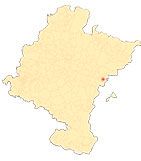Javier, a castle for a saint
External defences
Demolished in 1516, the outer defenses of the castle remained hidden for more than four centuries, replaced by a place, until the excavations of Fr. Recondo between 1952 and 1955 found their foundations and allowed their reconstruction. They consisted of two enclosures.
The first enclosure, closer to the castle and polygonal in shape, created a wall similar to a right angle in front of the main gate of the castle. Built in the 13th century, it was partially destroyed in 1455. When it was rebuilt, exterior slopes were added, inclined or stepped, typical of the 15th century. In the vertex of the angle a cube was placed from which the drawbridge arises, that allows to save a moat, conceived to separate this first enclosure of the outer barrier. The drawbridge communicated with a free-standing watchtower, located in front, wide and not very deep, able to form a bend and move the outer gate of the drawbridge, to leave the attackers unarmed. This "strong tower", probably higher and more closed than the present one, still attracted the attention of the witnesses of the demolition of 1516. A gate, protected by a machicolation and a drawbridge, connected this tower with the external ramp.
In the reconstruction of the castle in the second half of the 15th century, the albarrana tower was included in an outer wall or barrier of leave height, which surrounded the entire castle. The barrier was below 23 horizontal arrow slits that, within the same construction plan, ran along the tower of Undués and the northern polygon. This subject of barriers was generalized in the second half of the 15th century in large Castilian castles (Medina del Campo, Coca, Cuéllar, Belmonte, Ampudia, Monbeltrán, Simancas, etc.), which, with the exception of the distances, Javier tries to imitate.
In the demolition of 1516 the moats were filled with the stones of the walls, the arrow slits were blinded, and the machicolations were destroyed. The castle ceased to be a military fortress and became a stately palace.












